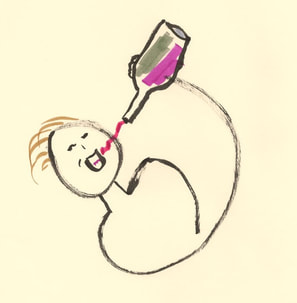 Garnacha is the one I would pour all over my face, in the town square, under the spotlight of the sun. Garnacha is the one I would pour all over my face, in the town square, under the spotlight of the sun. Have you ever met someone who causes you to lose all forms of self-control? For me, lusty Garnacha is the one I would pour all over my face, in the town square, under the spotlight of the sun. It would be reckless. Certainly illegal. It would be humiliating. And I would love every drop of that ruby red wine streaming out of the bottle and into my mouth. Onlooker shock would turn to bemusement at this shameless display of public affection. Intense relationships start hot, igniting the pleasure center in our brains, and Garnacha had me at hello. The origin of my intrigue with Garnacha lands squarely on the shoulders of Monica M., a key educator in my formal wine training and subsequent certifications. When wine classes are taught by a Spaniard, you quickly become curious about the wines of Spain and their many incarnations. I rummaged through the aisles of The Wine House in Los Angeles and picked up a bottle from Priorat, a hotbed of winemaking creativity and excellence in northeastern Spain. The bottle was a 2014 Mas Doix Les Crestes Priorat with a distinctive label featuring a rooster sporting a large red cockscomb. The wine was eighty percent Garnacha from twenty-year-old grapevines blended with ten percent old vine Carignan grapes and ten percent Syrah. Once home, I uncorked the bottle and just like that naughty Garnacha stole my heart. Red cherry, cranberry, strawberry, licorice and cinnamon aromas clouded my vision. I thanked my lucky stars for the pleasure that Garnacha gave me without reserve. But my conscience does not allow me to end the sweet memoir here. You, my friend, deserve more than a steamy love story. As with many affairs, there is a cautionary tale involved. While flooding your nose and mouth with spicy, red fruit flavors and aromas, Garnacha hides a dagger behind her back in the form of high alcohol. Garnacha’s alcohol by volume ranges from thirteen point five to sixteen percent; fifteen percent is very common. So you see, you will never be able to love her with the complete abandon she accords you. Tragically, Garnacha will always be the superior lover in this relationship, so keep your dignity, if you can, by girding your loins against the mischievous alcohol that is skillfully concealed by the best makers. The Mas Doix I drank that day, for example, was fourteen-point-five percent ABV. It is this very attribute of high alcohol, along with a full body, that attracted Burgundian winemakers in the seventeenth century to add her to their Pinot Noirs to make them more interesting. Experienced lovers have mysterious pasts, and Garnacha is no exception. There has been a tug-of-war among wine lovers about the origin of this grape. Some feel that Garnacha originated in Aragon in northern Spain. Others insist she was born in Sardinia. Like many, I am inclined to believe that she is of Aragon because this area has the widest range of Garnacha varieties (red, white, grey, Peluda). More importantly, Garnacha’s clonal diversity in Aragon eclipses that of Sardinia. Garnacha’s parents are unknown. She holds tight to her secrets.  She is an avid sunbather, even though she is thin-skinned, and she tolerates drought conditions with aplomb. She is an avid sunbather, even though she is thin-skinned, and she tolerates drought conditions with aplomb. The only way to know enigmatic Garnacha is to experience her attributes in the here and now. Garnacha has many hot spots of production, literally, as she prefers a warm or hot climate. She is an avid sunbather, even though she is thin-skinned, and she tolerates drought conditions with aplomb. In no hurry to impress, Garnacha is a late ripening grape; she takes her time. Pick her grapes too early and she cannot reach her peak of perfection. Her generous body is there strictly for your pleasure. Most famously, she is the key grape in the Southern Rhône’s Châteauneuf-du-Pape wines, where she is known fondly by her friends as Grenache. Châteauneuf wines showcase delicious Grenache, often with the blending partners of Syrah and Mourvèdre, to create full-bodied wines of spicy, concentrated red and black fruit. In vintages with hotter climates, Grenache can get overly jammy, so her blending partners help balance the final wine with tannins, color, acidity, and layered flavors. In some cases, such as Château Rayas, the very finest Châteauneuf is composed of one-hundred percent Grenache in lieu of using any of the thirteen permitted grape varieties for producing red Châteauneuf. An older vintage from Rayas can put you back two-thousand dollars for a single bottle. How does Château Rayas manage to produce what may be the Southern Rhône’s finest wines without the help of blending partners to correct her soft tannins and low acidity? For one thing, Rayas, located in the northeastern area of Châteauneuf-du-Pape, enjoys the coolest microclimate in the Southern Rhône, so the grapes are unlikely to be over-baked and flabby. Trees and forests exert a cooling influence on the soil. These advantages result in naturally lower yields and longer hang time for the grapes, turning up the dial on flavor intensity. With less heat, the grapes at Rayas preserve their precious acidity. Grapevines, under these conditions, grow at a pace conducive to tannin concentration. The terroir at Château Rayas makes it possible to harvest the grapes later in the season, at their perfect level of ripeness, without driving up the sugar level. The result: fresh, pure, silky wines that are lower in alcohol than those of many counterparts. In short, this wine is the very essence of elegance. The Dutch Golden Age painter Johannes Vermeer would have watered at the mouth to paint this Grenache beauty, a real pearl of a wine. Grenache is the most planted variety in the Southern Rhône. About half of the Southern Rhône’s wine production is labeled simply as Côtes du Rhône, and these are fruity, simple, medium-bodied red, white or rosé wines meant for casual consumption. If you thirst to investigate wines of a more serious nature, you can trade up to offerings that fall under the Côtes du Rhône Villages appellation. These wines have strict laws that address alcohol levels, permitted yields, and wine grape composition, along with other aspects of winemaking. The very best wines are cru wines, such as the Château Rayas from Châteauneuf that we discussed. A cru is a legally distinct region that is recognized for its quality and unique terroir. In Châteauneuf, many growers claim their vines are over one hundred years old. This age on Grenache contributes greatly to building a wine with deep flavors. Southern Rhône crus include Châteauneuf-du-Pape (the original cru of the Southern Rhône), Tavel and Lirac (best known for their Grenache-based rosés), Gigondas, Rasteau, Beaumes de Venise, Vacqueyras, Cairanne, and Vinsobres. By the way, Gigondas, located just ten miles away from Châteauneuf, provides a similar style of wine at a much lower price point. The wine there is getting so good that even experts may not be able to distinguish it from a Châteauneuf wine, but you will know the difference, expert or not, at the cash register. If you were standing in the middle of a typical vineyard in the Southern Rhône, you would find Grenache’s vines to be bush-trained, clinging low to the ground. This helps her withstand the area’s powerful north winds, known as the mistral. As you stood in the vineyard taking in the songs of the birds and thinking that life is good, you would marvel at the bounty of large stones covering the vineyard’s soil. The stones, known as galets, evoke a moon-like appearance. Why are they there? They absorb the sun’s rays during the day and warm the vineyards through the night. Go ahead . . . crouch down . . . touch the stones . . . and feel the warmth. This is old-school technology at its best, creating ripening conditions for our lovely growing girl. Grenache is also found in France’s Languedoc-Roussillon wine region, where she courts several blending partners such as Syrah, Mourvèdre, Carignan and Cinsault. 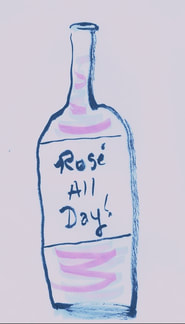 Grenache is one of the dominant varietals used in making the Provence rosé blends that are so hot right now. Grenache is one of the dominant varietals used in making the Provence rosé blends that are so hot right now. Grenache is one of the dominant varietals used in making the Provence rosé blends that are so hot right now. Her thin skin produces less color than, for example, a thick-skinned cabernet sauvignon grape that is rich in coloring matter. Lack of color makes Grenache an ideal blending grape for the production of the pale rosés that consumers fancy. I recognize Grenache anytime I taste her in a blend, especially in a rosé. As waves of wine roll around my tongue, it is as though Grenache’s blending partners evaporate, leaving her completely exposed, and (guess what?!) she doesn’t care. Grenache flaunts her flavors like nobody’s business. Back in Spain’s increasingly acclaimed Priorat wine region, classic blends are composed of old vine Garnacha and Carignan (known as Cariñena in Spain). The very best examples from this region are full-bodied and minerally, with flavors that might include a complex weave of brandied cherries, tar and licorice. These wines command some of the highest prices in the world. Priorat’s vineyards are hot and dry, much to Garnacha’s delight. Old grapevines struggle in nutrient-poor soils to produce very low yields and mouth-watering flavors. In the Rioja wine region of Spain, Garnacha contributes body, alcohol, and heady flavors and aromas to Tempranillo, the dominant variety there. While the neighboring Rioja and Navarra regions focus on Tempranillo-based wines, the Calatayud and Cariñena wine regions of Spain claim Garnacha as their most favored grape. Sardinia is a real player in the world of Garnacha, and on this island she is known as Cannonau. The Cannonau di Sardegna appellation covers the entire island. Many feel that the best examples are found on the eastern side. Italian scientists have unearthed information suggesting that Cannonau originated in Sardinia, not Aragon, so the ongoing tug-of-war over Garnacha’s birthplace will continue until indisputable proof surfaces. From time to time, my clients ask me to recommend a wine for medicinal or health purposes. Personally, I love this because it makes me feel like Doctor Lyne, though it is beyond my pay grade. In these cases, I sometimes call upon Cannonau’s restorative powers. Buyers get excited when they learn that Sardinian locals have extraordinarily long lifespans. We are talking about people who live into their nineties or to over one hundred years old. Some attribute this longevity to the Sardinian diet, including the wine. Cannonau is high in anthocyanins and polyphenols, antioxidant compounds that are thought to contribute to heart health. Who am I to challenge this thinking? The Sardinians are doing something right. You will also find Garnacha south of Sardinia on the island of Sicily, where the locals call it Alicante. Garnacha is a jet-setter, growing well in Australia’s Barossa Valley and McLaren Vale, and you will spot her on California’s Central Coast as well as South Africa and Israel. 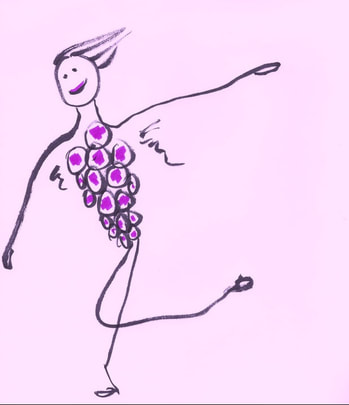 Garnacha Peluda is a variant of red Garnacha with the underside of the leaves displaying a peculiar hairy appearance, almost as though she forgot to shave her armpits. Garnacha Peluda is a variant of red Garnacha with the underside of the leaves displaying a peculiar hairy appearance, almost as though she forgot to shave her armpits. Garnacha expresses herself in varieties beyond the ruby red, known in Spain as Garnacha Tinta and in France as Grenache Noir. Garnacha Blanca, the white wine grape, is being produced as a one hundred percent varietal with a golden hue and a full body in Priorat and other Garnacha-centric Spanish wine regions. Look for characteristics that include floral notes, citrus, and ripe stone fruit accented with pinches of rosemary and thyme. Throughout the south of France, Grenache Blanc is produced as an easy drinker with low acidity and high alcohol, often presented with its traditional blending partner, Maccabéo. Châteauneuf-du-Pape produces white offerings, Grenache Blanc among them, that are weighty and intensely aromatic. You will also find Grenache Blanc on California’s Central Coast, especially San Luis Obispo. Garnacha comes in classic gray as well but it has limited worldwide production. Look for it in the south of France, where it goes by the name of Grenache Gris. This wine exudes apricot and stone fruit aromas and some examples have a satisfying, oily mouthfeel. It is a bit of an obscure wine but that in itself is interesting for those of us who are always on the lookout for something new. There is some production of this grape in Spain, South Africa and California. Grenache Gris is genetically one and the same as Grenache Noir and Grenache Blanc but simply has a pinkish-gray skin. Even though this grape is relatively rare, many feel that she is blessed with a more profound flavor than her white sister. Now we get to the hairy proposition of Garnacha Peluda. This is a variant of red Garnacha with the underside of the leaves displaying a peculiar hairy appearance, almost as though she forgot to shave her armpits. Clearly, this is the more earthy side of Garnacha. Peluda is planted throughout Spain and in southern France and has a lower alcohol content than traditional Garnacha. It is not unusual to find red Garnacha and Peluda in the same vineyards and they are often mixed together in fermentation and/or blending. What should you eat while drinking red Garnacha? The good news is that Garnacha is one of the world’s most versatile wines for pairing with food, mostly due to her pure red fruitiness, hint of citrus and other refreshing qualities. Her wide range of depths and textures, along with a kick of spice, are ideal with braised, grilled or stewed meats such as chicken, veal, lamb, beef, game and pork. Garnacha also pairs nicely with salmon and trout, especially when grilled. Match Garnacha’s spiciness with Indian food, though I would steer clear of very highly spiced food of any kind as wines that are high in alcohol make hot, spicy food taste even hotter. If you are not in the mood for meat, call on Garnacha for pairing with a mac and cheese dinner or a lentil- or bean-based dish. For white or gray Garnacha, as well as rosés, seafood is a natural. Think about fish tacos, crab cakes and garlic prawns. If you have read my blog post on food and wine pairings, you know that choosing wines that match the origin of the food is one way to start getting creative with your dinner planning. It is no surprise, then, that all colors of Garnacha pair well with the quintessential Spanish dishes of charcuterie and paella. Some winemakers harness Garnacha’s naturally high levels of alcohol and sugar to produce a fortified dessert wine known as Vin Doux Naturel. Drink this style on its own or pair it with dark chocolate, caramels, brownies, and cookies. These desserts also pair well with most other styles of Garnacha. If you are planning a cheese course with Vin Doux Naturel wine, you can reach for Brie, blue cheese, Cheddar, Gouda, Gruyère, and Manchego. I’ll let you in on a little secret: Spanish wines are among the best values available on the market. Many of the wines you already enjoy share some of the same characteristics found in red Garnacha and you may be able to pay less for the same quality by switching. If you get weak at the knees for Syrah, Amarone, Mourvèdre, Tempranillo, or even Merlot, consider a tryst with Garnacha. There, I’ve gone and done it again. This story is longer than most because I have, once more, lost all control when it comes to Garnacha. If you find yourself falling in love with her, it hurts me to tell you that you will be one of a long line of lovers. The awful truth may bruise your ego, but you will, in time, learn to accept Garnacha as she is and without complaint. In fact, the only way to upset her is to ignore her on the third of September, International Grenache Day. But you won’t do that because you want to have her around all the time. A bad day with Garnacha is better than a good day with anyone else, even if she leaves you crying on the street and making a public spectacle of yourself, yet again. Take my advice and resolve yourself to the fact that Garnacha is a woman you can’t forget . . . and that you will never leave. Garnacha: General Characteristics Flavors: cherry, raspberry, blackberry, candied fruit roll-up, cinnamon, white pepper, citrus skin, licorice, tobacco, oregano, lavender Acidity: low to medium Tannins: low to medium Texture: soft tannins Alcohol: high Body: medium- to full-bodied Key regions: Spain: Priorat, Rioja, Calatayud, Cariñena, Navarra, Montsant; Italy: Sardinia, Sicily; France: Southern Rhône, Châteauneuf-du-Pape, Languedoc-Roussillon, Gigondas; Australia: Barossa Valley, McLaren Vale; United States: California’s Central Coast Parents: unknown Origin: most likely Aragon in Northern Spain; possibly Sardinia Also known as: Grenache, Grenache Noir, Garnacha Tinta, Garnatxa, Cannonau, Cannonau di Sardegna, Lledoner, Tinto Aragones, Alicante, Granaccio
1 Comment
The first time I bought the wine it was suggested by the knowledgeable staff at The Wine House. When I start a new region of study, I lean heavily on recommendations then grow bolder with each shopping trip. Today, I picked the wine myself, mostly because I recognized the winery, Château Pégau, from the podcasts I follow. Full disclosure: My choice was also influenced by the buyer-friendly price in a region that makes me want to cry when I pay my AmEx bill. After rating the wine today, I was disappointed to realize I had already rated it, only one month prior! At first I cursed my horrible memory for the mistake. What a dummy! Then it dawned on me that this was an opportunity to assess the consistency of my tasting skills and consider the possible differences between bottles. Think about it: These wines were made by the same producer with the same grapes in the same year. The two bottles were cared for by the same shop. Could it be true that every bottle of wine is an individual, no different than ourselves? Though my ratings and tasting notes were not wildly different, my emotional response to the wines were night and day. Let's compare the facts, as listed on the Vivino tastings:
The score for the wines are .25 apart, if you read down to the final conclusions. Here's where the scenario gets tricky: the emotional response. The bottle in September: It's a nice quaff to go along with your sandwich. October: My God this is a good wine with a luscious mouthfeel and a backbone of acidity that tells me this vintner is on the mark. I'd like to give this wine a four! When I sat down today to give it an objective review, I dialed the score down to a 3.5, but doing so in no way diminished my euphoria.
How about you? Have you tasted two different bottles of the same wine and experienced both ho-hum and joyful moments? What do you think accounts for different emotional responses to a wine? Belly up to the bar and share your experiences. Discovering a recent AOC in the south of Rhone requiring 50% Grenache Some wines are like people you know, and the ones you love best: flawed but fascinating. In speaking with Lucky Lance at The Wine House in Los Angeles, I discovered a little known secret from the Southern Rhone: AOC Rasteau. Lucky Lance urged me to try this wine and I went for it. In spite of a dried-out cork and fusel alcohols from what I'm guessing is a warm fermentation, this wine from Aliane won my heart (see my notes on Vivino). This may sound crazy to you, but the moment I inhaled, I was infused with the glory of little trotters in a clean pig sty. We're talking barnyard and flaws in a wonderful way. What I've learned about Rasteau:
|
AuthorLyne Noella Archives
October 2022
Categories
All
|

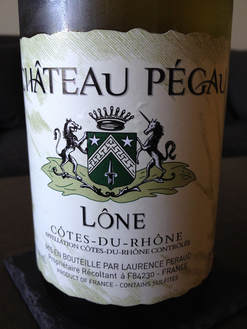
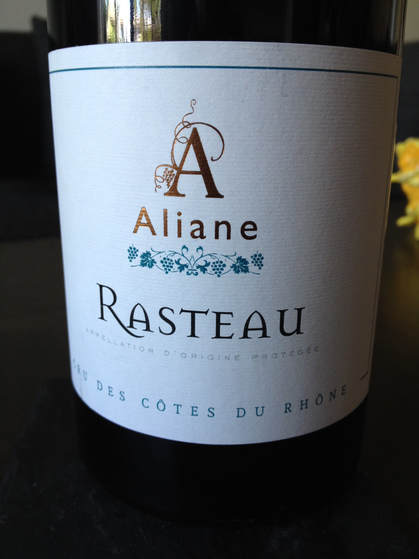

 RSS Feed
RSS Feed
